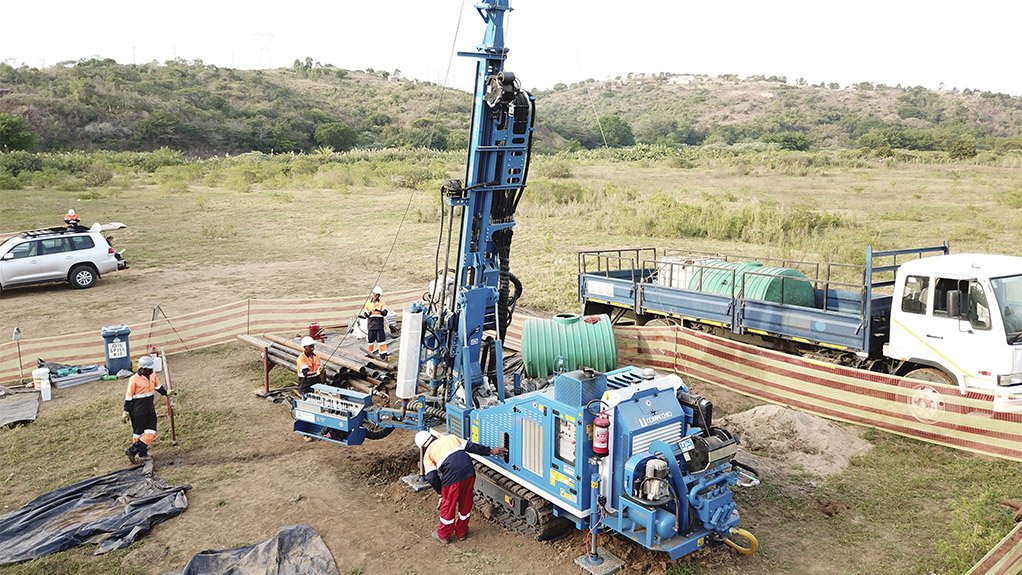Drill rig improves sample recovery in variable conditions


TWO HEADS ARE BETTER THAN ONE The dual-head Geo 601 drill rig is equally effective in soft and hard ground conditions
Increasing pressure on mining companies to publicly disclose information on their tailings dams highlights the need for improved technology to more accurately test dam stability and more reliably predict potential failures.
This was highlighted by the Brumadinho tailings dam failure in January, in Brazil, which resulted in the deaths of about 300 people at the Córrego do Feijão iron-ore mine, owned by Brazilian miner Vale.
South African geotechnical services provider GeoGroup founder Dave Rossiter believes that the Geo 601 dual-head drill rig – custom-made for Geomechanics by Italian drill rig manufacturer Commachio – is well suited to assessing ground conditions at tailings dam facilities more accurately.
This rig also enables tailings dam safety monitoring instruments to be easily installed into the drilled hole, since the sonic drilling method requires the hole to be cased in its entirety, thereby providing a fully cased hole on completion.
Geotechnical investigations company Geomechanics – a subsidiary of GeoGroup – imported such a rig – the only one of its kind in South Africa, according to Rossiter – last year at a cost of R6-million.
The Geo 601 dual-head drill rig comprises a rotary core drill head for standard core drilling applications in hard ground and a sonic drill head for softer ground conditions.
“If one wants good-quality samples for testing to better understand the potential for a tailings dam failure, then one needs to consider using sonic and rotary core drilling techniques in conjunction with each another,” Rossiter tells Mining Weekly.
The sonic head can be used to acquire good-quality samples from the soft tailings deposits in the dam, while the rotary core head can be used to drill into the hard rock beneath the dam, enabling geotechnicians to accurately record data on the interface between the two different ground conditions.
The dual-head capability negates the need for two separate rigs on site, which helps lower costs while accelerating the process.
“There is a global increase in demand for technology and instrumentation that can help avert potential tailings dam collapses,” Rossiter notes, adding that tailings policies are being scrutinised worldwide.
“With this renewed awareness of the need for better tailings dam stability monitoring, I think we’re going to see an increase in the demand for this particular rig.”
Conventional rotary core drilling does not automatically yield good core samples in all ground conditions, despite the use of split double- and triple-tube core barrels, as well as expensive drill muds to enhance core recoveries.
“When drilling in soft or weathered materials, it is often difficult to produce a good-quality core using conventional rotary core technology,” Rossiter explains. “This can be a source of frustration and, ironically, lost information when working in softer ground formations.”
Such information could be pertinent to the accurate assessment of tailings dam stability, he adds.
The sonic drill head allows for the soil sample to enter the single-tube core barrel by liquefying the ground on the sidewall of the sample that enters the core barrel without disturbing the sample, thereby providing good core recoveries in softer, more friable ground.
The sonic vibration is created by the resonance in the sonic drill head, which then transfers down into the drill rod and core barrel. This sonic resonance is prevented from going into the drill head and causing damage to the machine by an air spring, which isolates the vibration.
“Sample recoveries in soft-ground conditions using sonic technology are usually more than 95%,” Rossiter points out. “However, it cannot be used in hard ground formations. This is where the dual-head capability comes in handy.”
The Geo 601 drill rig can drill up to a depth of 60 m using the sonic head and a depth of 200 m using the rotary core head.
Comments
Press Office
Announcements
What's On
Subscribe to improve your user experience...
Option 1 (equivalent of R125 a month):
Receive a weekly copy of Creamer Media's Engineering News & Mining Weekly magazine
(print copy for those in South Africa and e-magazine for those outside of South Africa)
Receive daily email newsletters
Access to full search results
Access archive of magazine back copies
Access to Projects in Progress
Access to ONE Research Report of your choice in PDF format
Option 2 (equivalent of R375 a month):
All benefits from Option 1
PLUS
Access to Creamer Media's Research Channel Africa for ALL Research Reports, in PDF format, on various industrial and mining sectors
including Electricity; Water; Energy Transition; Hydrogen; Roads, Rail and Ports; Coal; Gold; Platinum; Battery Metals; etc.
Already a subscriber?
Forgotten your password?
Receive weekly copy of Creamer Media's Engineering News & Mining Weekly magazine (print copy for those in South Africa and e-magazine for those outside of South Africa)
➕
Recieve daily email newsletters
➕
Access to full search results
➕
Access archive of magazine back copies
➕
Access to Projects in Progress
➕
Access to ONE Research Report of your choice in PDF format
RESEARCH CHANNEL AFRICA
R4500 (equivalent of R375 a month)
SUBSCRIBEAll benefits from Option 1
➕
Access to Creamer Media's Research Channel Africa for ALL Research Reports on various industrial and mining sectors, in PDF format, including on:
Electricity
➕
Water
➕
Energy Transition
➕
Hydrogen
➕
Roads, Rail and Ports
➕
Coal
➕
Gold
➕
Platinum
➕
Battery Metals
➕
etc.
Receive all benefits from Option 1 or Option 2 delivered to numerous people at your company
➕
Multiple User names and Passwords for simultaneous log-ins
➕
Intranet integration access to all in your organisation



















